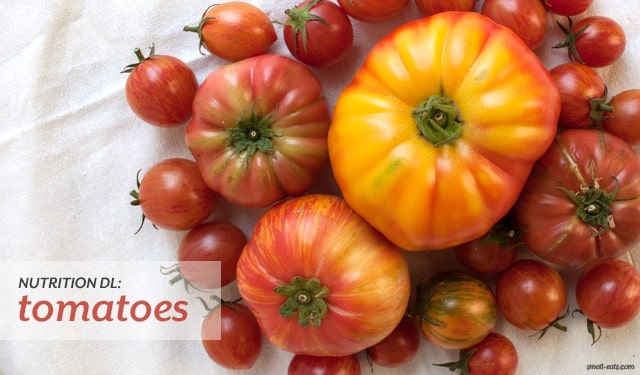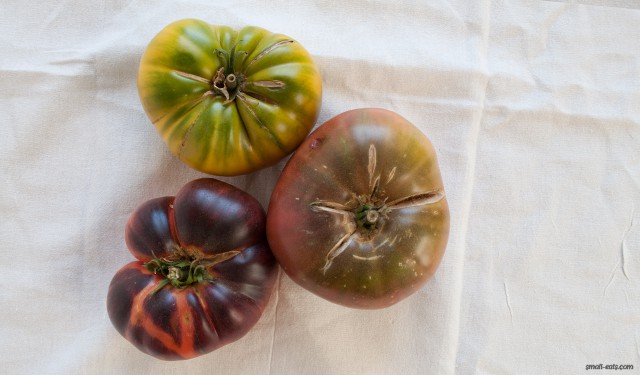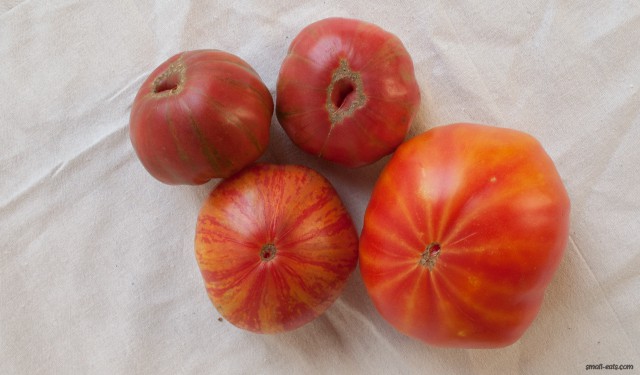
Summer has officially hit when you walk the aisles of your produce section or farmer’s market and are surrounded by beautiful, glossy tomatoes. Smooth on the outside, squishy and messy on the inside, they’re the perfect ingredient to add to your table this season. Incredibly versatile, tomatoes can be made into soups, sauces, added to salads, eaten raw, made into salsas or dips… and they have great health benefits to boot!
Benefits
A tomato’s rich reds or vibrant yellows are attributed to carotenoids, which are natural red, orange, or yellow pigments. Tomatoes have not one, but four kinds of carotenoids, including beta-carotene. Once eaten, your body converts them into vitamin A. Vitamin A from plant sources help with inflammation, immunity, and cell health.
Tomatoes are an extremely rich source of lycopene, an antioxidant that studies say can lower the risk of heart disease, macular degeneration, and can lower the bad cholesterol, LDL.
Trying to boost your bone strength? Reach for the tomato. Tomatoes have 18% of the recommended requirement of vitamin K, which contributes to bone health.
In addition to helping your bones, Tomatoes are also high in potassium. This can help keep blood pressure in check. So if you’re watching your blood pressure, experiment with incorporating more tomatoes into your diet.

Kinds of Tomatoes
There are over 7000 varieties of tomatoes, classified by their size. If you’re looking for larger tomatoes to stuff or put atop a burger or in a sandwich, look for slicing, globe, beefsteak, or oxheart tomatoes. Slightly smaller and less round varieties include plum, pear, and Campari tomatoes. If you love canned San Marzano tomatoes for sauces, you’ve eaten a plum tomato. The little guys, perfect for skewering and salads, are cherry and grape tomatoes.
If you shop at a farmer’s market, the majority of the tomatoes you see will probably be heirlooms. Heirloom tomatoes come from seeds that haven’t been altered by human hybridizing. Their seeds have been saved and cultivated over generations.
You can tell the difference between an heirloom tomato and a conventially grown one pretty easily. Heirlooms typically are covered in beautiful streaks and are uniquely shaped. Rarely do two heirloom tomatoes look alike. Some people may classify that as ugly or funny shaped, but what the heirloom lacks in uniformity, it makes up for in a more intense and tomatoey flavor. Heirlooms also come in a wider variety of colors (even purple!) and some of them have a wonderful mixture of colors.
Buying and Storing Tomatoes
Because tomatoes are thin-skinned, I strongly recommend buying organic or no-spray, no-pesticide tomatoes. Thin-skinned fruits and vegetables absorb more pesticides, and who really wants to eat chemicals?
When it comes to buying fresh tomatoes, go with the seasons. Summer is the season for tomatoes. This is time to buy and enjoy all the fresh tomatoes you can get your hands on. Tomatoes bought out of season are predominately commercially grown and not always organic. The chances of seeing an heirloom tomato in the fall and winter are slim to none. Out of season tomatoes are also seriously lacking in any sort of flavor. After having your fill of heirloom and organic tomatoes, you won’t be able to go back to the tasteless, often mealy off-season varieties. Most canned tomatoes have been canned during the peak of the season, and still look for organic, BPA-free options.
When looking for your perfect tomato, make sure it’s firm, but not rock hard. Unless you’re making sauce, avoid softer tomatoes. This will just get messy. Check for blemishes, holes, knicks, and obviously, mold. If you can, pick up your tomatoes last and carry them separately (especially at the farmer’s market) to prevent any bruising or crushing.

Once home, store them on the counter. If you brought home larger tomatoes (not cherry or plum) store them stem side down, with the bottoms facing up. This will keep the potential bruising area low and from rolling around. You can store tomatoes in the refrigerator, but does affect their flavor. That being said, I have stored tomatoes in the fridge (especially if I’m making a tomato based recipe in a few days). So it’s up to you. The tomato police will not get you if you put your tomatoes in the fridge for a few days.
For the next few weeks, I’ll be sharing a few ways you can bring this summer fruit to your table. Check back tomorrow for the first way!
